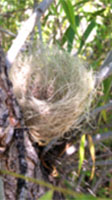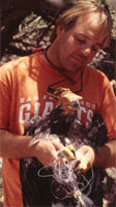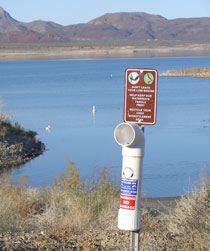The Arizona Game and Fish Department (AZGFD) would like to remind all anglers that the improper use and disposal of fishing
line (monofilament) can have a dramatic impact on wildlife. In addition to being an eye-sore along our
waterways, many shore birds, migratory birds, waterfowl, and raptors have become entangled in monofilament and died. The
Monofilament Recovery Program (MRP) was implemented to clean up Arizona's recreation areas and reduce the impacts of fishing line on wildlife. As part of the MRP, at least 85 recycling bins for monofilament have been placed at lakes and rivers throughout the state, targeting bald eagle breeding areas and high-use recreation sites.
How Animals Come In Contact with Monofilament
There are a variety of ways animals encounter monofilament. Shore birds and waterfowl have been entangled in
the litter while wading or swimming. Raptors and fish-eating waterfowl have ingested hooks and monofilament
from fish that broke the line. Some migratory birds have used it as nesting material.
Starvation is the most common demise for animals encountering monofilament. The line wraps around the neck or
accumulates in the stomach, preventing the ingestion of food. It can also immobilize the animals by wrapping
around the legs, or securing them to stationary objects.
In a study of Arizona's bald eagle breeding population, half of the breeding areas have recorded monofilament
entanglement or its presence in the nest. Two bald eagle nestlings have died from starvation due to monofilament.
For more information on how monofilament affects bald eagles, read AZGFD's
presentation on monofilament.

A migratory bird nest made entirely
from monofilament, leaders, hooks
and weights. Birds often mistake
discarded monofilament as nesting
material.

A nestling bald eagle is rescued after being
entangled in monofilament. The adult bald eagles
caught and delivered a fish that broke the line.
Help keep our waterways tangle free
Protect wildlife by:

- Disposing of unwanted fishing line in the monofilament recycling bins (pictured) located at many waterways around the state, or at participating license dealers and tackle shops. Fishing line can be recycled into tackle boxes, lures, and other plastic items. If the retailer you visit does not have a recycling bin then encourage them to participate in the program.
- Using the appropriate test line for the desired fish and fishing technique. A six pound test line will work great for crappie and small-mouth bass, but a 20 pound test should be used for flathead catfish. In addition, trolling or bank fishing anglers should use a stronger pound test line than those casting or jigging.
- Replacing your fishing line yearly. Over time normal wear-and-tear, plus Arizona's extreme temperatures and ample sunlight, can cause monofilament to become damaged or brittle. By regularly replacing your monofilament line, you can reduce the chance of breaking it..
- Taking the initiative while enjoying Arizona's waters and pick up discarded monofilament along the shores. Volunteer to build or install a recycling bin, participate in a cleanup event, or sponsor a recycling bin and empty it of line on a monthly basis.
For additional information
Kyle McCarty
Bald Eagle Field Projects Coordinator
Arizona Game and Fish Department
5000 West Carefree Highway
Phoenix, Arizona 85086-5000
623-236-7569
baldeagle@azgfd.gov



